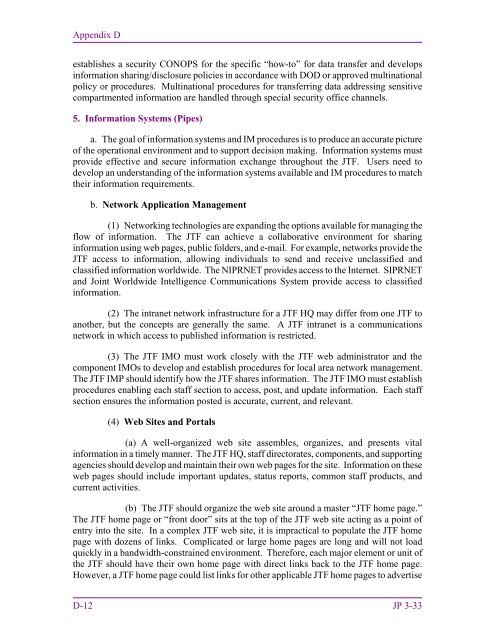JP 3-33, Joint Task Force Headquarters - Defense Innovation ...
JP 3-33, Joint Task Force Headquarters - Defense Innovation ...
JP 3-33, Joint Task Force Headquarters - Defense Innovation ...
You also want an ePaper? Increase the reach of your titles
YUMPU automatically turns print PDFs into web optimized ePapers that Google loves.
Appendix D<br />
establishes a security CONOPS for the specific “how-to” for data transfer and develops<br />
information sharing/disclosure policies in accordance with DOD or approved multinational<br />
policy or procedures. Multinational procedures for transferring data addressing sensitive<br />
compartmented information are handled through special security office channels.<br />
5. Information Systems (Pipes)<br />
a. The goal of information systems and IM procedures is to produce an accurate picture<br />
of the operational environment and to support decision making. Information systems must<br />
provide effective and secure information exchange throughout the JTF. Users need to<br />
develop an understanding of the information systems available and IM procedures to match<br />
their information requirements.<br />
b. Network Application Management<br />
(1) Networking technologies are expanding the options available for managing the<br />
flow of information. The JTF can achieve a collaborative environment for sharing<br />
information using web pages, public folders, and e-mail. For example, networks provide the<br />
JTF access to information, allowing individuals to send and receive unclassified and<br />
classified information worldwide. The NIPRNET provides access to the Internet. SIPRNET<br />
and <strong>Joint</strong> Worldwide Intelligence Communications System provide access to classified<br />
information.<br />
(2) The intranet network infrastructure for a JTF HQ may differ from one JTF to<br />
another, but the concepts are generally the same. A JTF intranet is a communications<br />
network in which access to published information is restricted.<br />
(3) The JTF IMO must work closely with the JTF web administrator and the<br />
component IMOs to develop and establish procedures for local area network management.<br />
The JTF IMP should identify how the JTF shares information. The JTF IMO must establish<br />
procedures enabling each staff section to access, post, and update information. Each staff<br />
section ensures the information posted is accurate, current, and relevant.<br />
(4) Web Sites and Portals<br />
(a) A well-organized web site assembles, organizes, and presents vital<br />
information in a timely manner. The JTF HQ, staff directorates, components, and supporting<br />
agencies should develop and maintain their own web pages for the site. Information on these<br />
web pages should include important updates, status reports, common staff products, and<br />
current activities.<br />
(b) The JTF should organize the web site around a master “JTF home page.”<br />
The JTF home page or “front door” sits at the top of the JTF web site acting as a point of<br />
entry into the site. In a complex JTF web site, it is impractical to populate the JTF home<br />
page with dozens of links. Complicated or large home pages are long and will not load<br />
quickly in a bandwidth-constrained environment. Therefore, each major element or unit of<br />
the JTF should have their own home page with direct links back to the JTF home page.<br />
However, a JTF home page could list links for other applicable JTF home pages to advertise<br />
D-12 <strong>JP</strong> 3-<strong>33</strong>

















